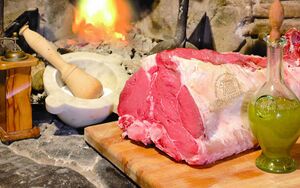Vitellone bianco dell'Appennino centrale (Central Apennine white veal)

IGP Vitellone bianco dell'Appennino centrale is white veal from the Central Apennines region of Italy and consists in the meat of pure-bred chianino, marchigiano or romagnolo male or female animals aged between 12 and 24 months. The animals are from selective breeding herds and are duly registered on birth in the young animals' herd book.
The geographical area of production of "vitellone bianco dell'Appennino centrale" comprises the territory of the provinces located along the central Italian Apennińe chain. To be more precise, it covers the present territory of the following provinces: Bologna, Ravenna, Forlì, Rimini, Pesaro, Ancona, Macerata, Ascoli Piceno, Teramo, Pescara, Chieti, l'Aquila!, Campobasso, Isernia, Benevento, Avellino, Prosinone, Rieti, Viterbo, Temi, Perugia, Grosseto, Siena, Arezzo, Firenze, Prato, Livorno and Pisa, except for the commons expressly indicated in the specifications.
The chianino, marchigiano and romagnolo breeds share a common origin and history. The high point of their development was during the period of share-farming; they were developed in the typical share-tenancy farms of the hillsides of central Italy, where they were first used for work in the fields and later, from the mid-19th century, subjected to selection as specialised meat breeds.
The calves of the white breed of the Central Apennines suckle naturally their dams until weaning, after which the basic diet consists of grassing and/or forage from natural or artificial grassland and herbaceous crops typical of the geographical area identified.
For the following stages, including the fattening period to slaughter, the animals must be reared exclusively in open air housing or stall housing facilities. Slaughter takes place in suitable abattoirs situated within the production area.
The link between the geographical area and the product results from a combination of genetic heritage, rearing practice and climate; the meat is not subject to surface browning, even after cutting up and display on the butcher's counter, and there is very little reject meat.
Rearing practices are very closely linked to traditional systems of stall or partially open housing ΐοτ fattening animals, and the feed used during the fattening period is mainly produced on the holding. Most farms practise so-called closed circuit production, bringing calves born on the farm up to slaughter weight.
The main characteristics of the product are determined firstly by the fact that the animals belong to three local cattle breeds, which have been reared for centuries in the area described in the specifications. The Apennines have a well-defined ecosystem as regards climate, temperature changes and rainfall patterns. These environmental conditions, which are also linked to the morphology and particular position of the land, have produced a varied and highly characteristic pastureland. The pastures also derive their special identity from essential elements, such as specific aromatic components and pigmentation. The meat absorbs these environmental influences, resulting not only in differences in organoleptic properties, but also in muscle mass, fibrous tissue and fat. As the animals live in freedom most of the time, their biological cycle is closely linked to their geographical environment.
Reference: The European Commission